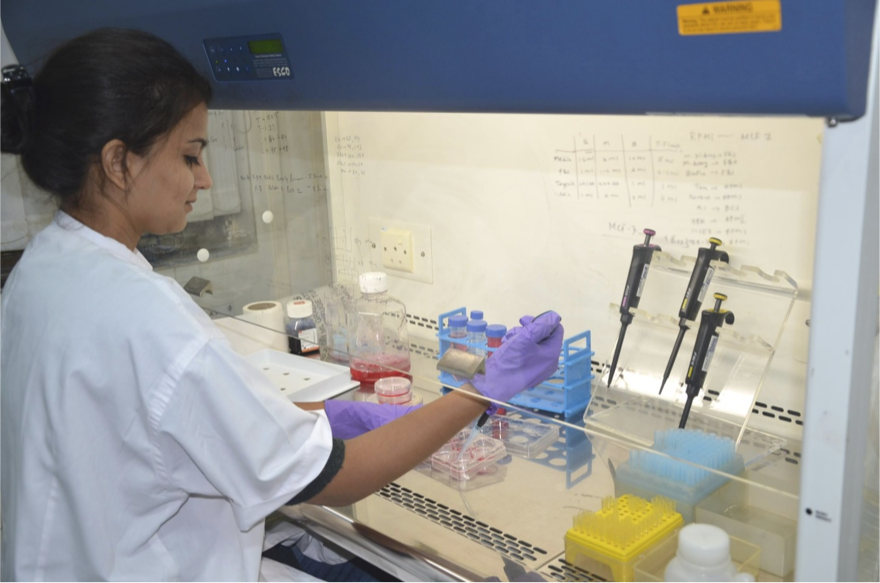Scientists at ACTREC investigate the functional significance of DNA fragments released into the bloodstream by dying cells.

In a healthy physiological mileu, cells are constantly dying and being replaced by mitosis. Dying cells release considerable amounts of DNA fragments (DNAfs) and chromatin fragments (Cfs) into the blood circulation during the programmed cell death process, apoptosis. The presence of these Circulating Nucleic Acids (CNAs) have been known for quite some time, yet their functional significance remained unclear. The authors of a recent study, from ACTREC, Navi Mumbai, have leveraged their findings to propose a new theory that attempts to fill this lacuna.
Indraneel Mittra, cancer surgeon and scientist, and the principal investigator of this study, explained that the fact that measurable quantities of nucleic acids circulate in healthy individuals as well as in patients with various disease pathologies is now well established. DNA and chromatin levels in circulation are known to be elevated in multiple acute and chronic human disorders that include cancer, trauma, auto-immune disorders and diabetes. DNA and chromatin levels also rise with advancing age. These features make CNAs potential biochemical and genetic biomarkers for a variety of pathologies especially cancer, thus underlying their possible diagnostic utility. But what could be their functional significance?
Blood from seventy consenting participants (cancer patients and healthy controls) was collected and analyzed for the study. The procedure involved isolation, characterization and quantification of circulating DNAfs and Cfs. The isolated CNAs were then tested with cultured cell-lines. Remarkably, the researchers found that the CNAs were readily taken up by the cells, in just a matter of minutes. They also found that the uptaken CNAs integrated with the host cell genomes of cells in culture. This was further confirmed when, upon injecting human-derived CNAs into mice, these DNA sequences were uptaken and integrated with the mouse genomes of various tissue types. The study went further to show that integrated CNAs are capable of inducing DNA damage and eventually, cell death in many cases. Interestingly, both the cellular uptake and induced genomic damage were found to be greater with CNAs derived from cancer patients than those from healthy participants, thus indicating the role CNAs might have in diseases like cancer.
Based on the results obtained, the authors have proposed a new model for DNA damage induced by circulating DNAfs and Cfs: Previous research has established that when cellular DNA is damaged, repair pathways come into action to rectify the adverse effects and maintain DNA integrity. When circulating DNAfs and Cfs are uptaken by a cell, ironically, the same repair pathways of the cell identify them as broken parts of ‘self DNA’ and thus activate DNA repair, facilitating integration of these CNAs into the cellular genome. This mistaken repair process and consequent integration leads to DNA damage as observed from the cellular DNA Damage Response (DDR) signal obtained from host cells in their experiments. The authors have shown for the first time that CNAs do have patho-physiological roles and act as DNA damaging agents after being freely uptaken by healthy cells.
The normal cell degeneration process gives rise to CNAs which can potentially damage DNA. According to Mittra, the incremental effect of such DNA damage might contribute to ageing as well as disease conditions like cancer in which CNAs might trigger specific type of disease-causing genomic rearrangements. This study establishes a functional link between CNAs and disease, thus validating ongoing scientific efforts in developing tools for diagnosing disease by measuring levels of CNAs in blood. In one of their experiments, the researchers show that CNAs can be degraded by either the enzyme DNase I (in case of DNAfs) and by both DNase I and anti-histone antibody complexed nanoparticles (in case of Cfs). These findings provide an approach to the possible cure of many diseases and perhaps retardation of ageing.
The results of this study have far-reaching ramifications in the theory of human health and disease. Mittra sums them up, saying, “DNA acquires a new life after cell death. It seems to act in both the paradoxical roles of preserver and destroyer of life”.